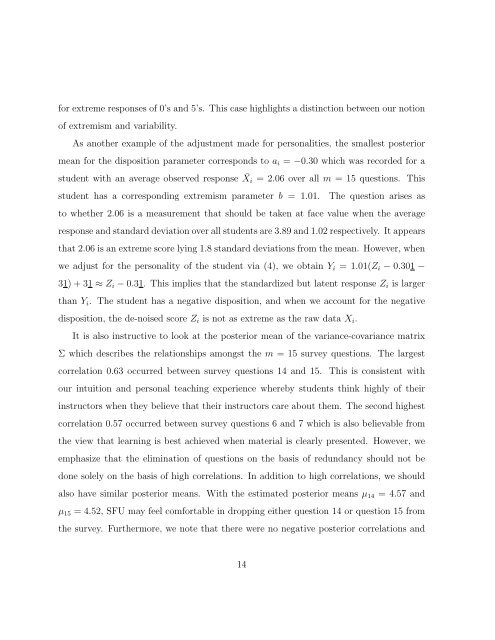Bayesian analysis of ordinal survey data using the Dirichlet process ...
Bayesian analysis of ordinal survey data using the Dirichlet process ...
Bayesian analysis of ordinal survey data using the Dirichlet process ...
You also want an ePaper? Increase the reach of your titles
YUMPU automatically turns print PDFs into web optimized ePapers that Google loves.
for extreme responses <strong>of</strong> 0’s and 5’s. This case highlights a distinction between our notion<strong>of</strong> extremism and variability.As ano<strong>the</strong>r example <strong>of</strong> <strong>the</strong> adjustment made for personalities, <strong>the</strong> smallest posteriormean for <strong>the</strong> disposition parameter corresponds to a i = −0.30 which was recorded for astudent with an average observed response ¯X i = 2.06 over all m = 15 questions. Thisstudent has a corresponding extremism parameter b = 1.01. The question arises asto whe<strong>the</strong>r 2.06 is a measurement that should be taken at face value when <strong>the</strong> averageresponse and standard deviation over all students are 3.89 and 1.02 respectively. It appearsthat 2.06 is an extreme score lying 1.8 standard deviations from <strong>the</strong> mean. However, whenwe adjust for <strong>the</strong> personality <strong>of</strong> <strong>the</strong> student via (4), we obtain Y i = 1.01(Z i − 0.301 −31) + 31 ≈ Z i − 0.31. This implies that <strong>the</strong> standardized but latent response Z i is largerthan Y i . The student has a negative disposition, and when we account for <strong>the</strong> negativedisposition, <strong>the</strong> de-noised score Z i is not as extreme as <strong>the</strong> raw <strong>data</strong> X i .It is also instructive to look at <strong>the</strong> posterior mean <strong>of</strong> <strong>the</strong> variance-covariance matrixΣ which describes <strong>the</strong> relationships amongst <strong>the</strong> m = 15 <strong>survey</strong> questions. The largestcorrelation 0.63 occurred between <strong>survey</strong> questions 14 and 15. This is consistent withour intuition and personal teaching experience whereby students think highly <strong>of</strong> <strong>the</strong>irinstructors when <strong>the</strong>y believe that <strong>the</strong>ir instructors care about <strong>the</strong>m. The second highestcorrelation 0.57 occurred between <strong>survey</strong> questions 6 and 7 which is also believable from<strong>the</strong> view that learning is best achieved when material is clearly presented. However, weemphasize that <strong>the</strong> elimination <strong>of</strong> questions on <strong>the</strong> basis <strong>of</strong> redundancy should not bedone solely on <strong>the</strong> basis <strong>of</strong> high correlations. In addition to high correlations, we shouldalso have similar posterior means. With <strong>the</strong> estimated posterior means µ 14 = 4.57 andµ 15 = 4.52, SFU may feel comfortable in dropping ei<strong>the</strong>r question 14 or question 15 from<strong>the</strong> <strong>survey</strong>. Fur<strong>the</strong>rmore, we note that <strong>the</strong>re were no negative posterior correlations and14
















